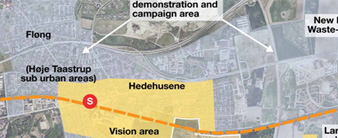The Høje Taastrup Community |
|
 |
|
| The Høje Taastrup development area. |
 View the whole picture View the whole picture |
|
Background |
The
vision plan of Høje-Taastrup Municipality was adopted by
its local communities to improve quality of life by prioritizing
health, exercise, recreation and sustainable town development, aspects
that all should contribute to improved public health and environment.
As part of this process, the municipality has updated the
climate action plan with objectives of reducing CO2 emission by >2%
on a yearly basis for the municipal institutions as well as for the
whole municipality as such.
The number of inhabitants in the
municipality is approx 46,000. The ECO-Life community demonstration is
located in the western area of Høje-Taastrup municipality, including
the suburbs of Hedehusene, Fløng and Gammelsø, which currently have a
population of 12,000 expected to increase by 6-7,000 persons due to
further development of the town area. Thus, the project will affect the
daily life of 12-18,000 people living in the town. |
The development area
|
| An
important aspect of the ECO-Life project is the Gammelsø area of the
Concerto community, which is a mixture of green field, old industrial
and building area to be transformed to a sustainable CO2 neutral
community. The area will be a prototype for sustainable town
development, rehabilitation and transformation hosting several
experimental solutions. The ECO-Life community areas of Fløng and
Hedehusene are characterised by existing buildings, dwellings and
single-family houses mostly built since the 1960s. The energy
efficiency of the houses to be refurbished will be improved by about
50%. |
Energy efficiency and energy savings in buildings
|
According
to the plan of the Vision area, the station centre will be renovated
and extended, and the industrial area of 100,000 m2, where an old
concrete factory was situated, will be converted into a commercial and
housing area. Moreover, another area of 100,000 m2 will also be
converted into a housing and institution area, with partial renovation
and reconstruction of the old industrial buildings.
Finally, adjacent undeveloped areas,
owned by the municipality, will be developed for housing, initially
400,000 m2 and later on further 800,000 m2. There will be a large
variety of houses from multi-flat houses in 4-12 stories, city houses,
over dense terraced houses in 2-3 storey houses to single /double
houses housing for domestic, commercial and institutional use. The
intention is to include around 2,500 dwellings in phases 1 and 2. |
Low energy houses and refurbishments
|
| The
buildings on the sites owned by the municipality will be developed for
low-energy standard and some of them will be passive houses and even
plus-energy houses. For the buildings in existing areas, efforts will
focus on developing ESCO services, support and financing mechanisms
aimed at improving energy efficiency and RES level of around 27,000 m2
of buildings. |
The test house: Energy Flex house
|
| The
main energy-efficiency solutions applied have been tested and adjusted prior to application to ensure that they are
user-friendly and effective. This will be done in the nearby Energy
Flex House at the Danish Technological Institute, which is a facility
for the development, testing and demonstration of integrated innovative
energy solutions for the built environment, i.e. solutions where the
interaction of buildings, installations, users and overall energy
system are crucial for the adaptation, usage and actual performance of
otherwise well-documented single technologies. |
Renewable energy supply
|
The
ECO-Life community is supplied partly by district heating and
partly by individual heat solutions. Just beside the area, a (95/55ºC)
transmission pipe owned by the transmission company VEKS is located.
The intention is to utilize this for energy exchange in the system, so
that the return heat from the VEKS pipe is used again in a
low-temperature district heating network operating at 53/25ºC to supply
the new building areas.
As far as electricity is concerned, emphasis has first and foremost been
put on promoting energy-efficient solutions, installations, controls
etc., which can reduce the electricity consumption at all levels,
including street lighting. Then, different
types of renewable energy for production have been implemented, including
1 wind turbine to be monitored as well as application of
building integrated solar cells.
Another element in the energy supply of the
overall community is the use of separated organic waste for
biogasification. The biogas will be used in public transport and for
generation of electricity and district heating at a higher
power-to-heat ratio than incineration of the residual in a large new
waste-to-energy facility that will be built during the project period. |
|
 To Top
To Top
|
|
|
|
|
|
|
PROJECT AND SUBCOORDINATORS |
|
|
|
 |
|
|
|
|
